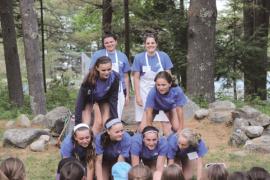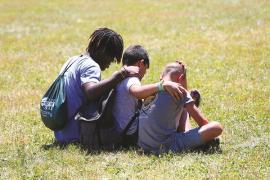Camp can offer a child more than mere fun. Camp is also the ideal environment to help campers develop their problem-solving skills.
Children learn problem solving through trial-and-error and modeling (watching how adults solve problems). Camp, with its community living focus, presents a constant source of potential conflicts and, thus, incidents in which to practice problem-solving skills. Camp also offers endless observation of how others (especially counselors) solve daily problems.
Successful Problem Solving
Children have a limited repertoire of responses when involved in a conflict; the first solution that comes to mind is often acted upon. This is one reason why young children often react aggressively, hitting or pushing the other child, when faced with a conflict. Adults, in comparison, have the ability to consider various responses and weigh the consequences of each.
Successful interpersonal problem solving results in win-win solutions where all parties involved in a conflict are satisfied with the resolution. Each positive resolution to a conflict is a learning experience that lays a foundation for mature and insightful problem solving in the future.
Steps in Problem Solving
When a conflict occurs, the first step is to refrain from action. Children often act impulsively before accurately assessing the entire situation. Slowing down enables the parties to assess the other person's feelings and to come up with possible solutions.
Assess the situation
Attempt to determine how the other person is feeling by looking at his facial expression and body language. Since this is only a guess, you should also ask simple questions, such as "How are you feeling?" or "What happened?"
Determine each party's goals
Determine what each camper desires as an outcome. What resolution would best satisfy him or her?
Brainstorm Solutions
Have each camper think of as may ways to reach the desired goal as possible. The more ideas, the more possibilities for resolution. Even if some of the ideas are completely untenable, they are still accepted as possible solutions. Brainstorming requires uncritical initial acceptance of all ideas; the ones that are outlandish can be disposed of during the next step.
Select a course of action
Each of the brainstormed responses has possible repercussions if acted upon. What are the pros and cons of each idea? One choice may only increase the severity of the conflict or result in smoldering bad feelings for one or all parties in the conflict. Another idea may have a more equitable and positive outcome. The major objective in this step is to determine what effect(s) the chosen plan of action will have on the other person in the conflict.
Carry out the plan
Act upon the plan that will accomplish the desired major goal and, at the same time, result in minimal stress or further conflict in the relationship. If you are unable to reach a win-win solution, then repeat step three until a resolution is found.
Problem solving by this method may appear to be a lengthy and tedious process, and, at first, it is. Having to walk through a long series of steps is rarely exciting. With practice, however, this process will become automatic.
Camp as Life's Classroom
There are many times during the camp day when you can teach problem-solving skills. Also, keep in mind your interactions with campers and other camp staff can be excellent examples for campers to observe you solving problems effectively.
Staff's everyday interactions
When faced with the common but nevertheless frustrating incidents that occur with campers (e.g., lateness for meals; untidy cabins; lack of cooperation in quieting down in cabins at bedtime), camp staff can actively model problem solving. By sitting with campers and verbally walking through each step to exhibit how a certain decision is formulated, they will learn the necessary cognitive steps for their own attempts. Counselors come to a camp expecting to teach a multitude of skills such as swimming and crafts; problem solving is simply an elaboration of the position's responsibilities.
Daily bunk meetings
At a pre-arranged time daily, hold an informal meeting to discuss the major events of that day. Discuss any conflicts that occurred. If a counselor witnesses an altercation between two campers, present this and request feedback from the entire group on the success of how the campers solved the problem. The other campers in the group can offer alternative solutions and possibly perform a role play.
Campers' daily interactions
After witnessing counselors solve problems and, practicing problem solving during bunk meetings and amongst themselves, campers can begin to use the steps in their daily interactions. When conflicts occur, staff can intervene and remind the involved individuals of their problem-solving abilities. Staff may need to walk through the entire sequence or simply initiate the process and let campers work it out on their own.
As children grow into adulthood, the memories of their camp experiences may be lasting treasures, but the social skills they develop while at camp may be a major reason for success in life.
Problem Solving in Action
The following is an example of problem-solving skills in action.
William is the waiter for the afternoon meal. While returning to his table carrying a plate of sandwiches, he is pushed from behind and drops the food onto the floor. William's immediate reaction is to turn around and punch the other camper who caused this incident. He remembers the problem-solving skills that his counselors have been teaching for the past week and refrains from immediate action (step 1).
The camper standing behind him, Carl, has an embarrassed look on his face. William notices the facial reaction and also asks what happened (step 2). Carl explains that he slipped on the floor and accidentally fell into William. William decides that the major resolution of this problem requires cleaning the spilled sandwiches and obtaining another plate of food (step 3).
William considers several options: tell his counselor who will then take control of the situation; demand that Carl both clean and retrieve the food; work out a compromise in which both of them are responsible for managing the predicament (step 4). The only solution that will probably not result in bad feelings and possible further escalation is the third alternative: cooperative clean-up (step 5).
Originally published in the 1999 May/June issue of Camping Magazine.



